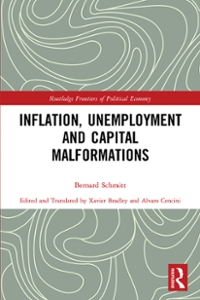5. Two countries, Richland and Poorland, are 3. LaunchPad . In the United States, the capital described by the Solow growth model. They have share of GDP is about 30 percent, the average the same Cobb-Douglas production function, growth in output is about 3 percent per year, F(K, L) = A KOL' -, but with different quanti- the depreciation rate is about 4 percent per ties of capital and labor. Richland saves 32 percent year, and the capital-output ratio is about of its income, while Poorland saves 10 percent. 2.5. Suppose that the production function is Richland has population growth of 1 percent per Cobb-Douglas and that the United States has been in a steady state. (For a discussion of year, while Poorland has population growth of the Cobb-Douglas production function, see 3 percent. (The numbers in this problem are cho- sen to be approximately realistic descriptions of Chapter 3.) rich and poor nations.) Both nations have tech- a. What must the saving rate be in the initial nological progress at a rate of 2 percent per year steady state? [ Hint: Use the steady-state and depreciation at a rate of 5 percent per year. relationship, sy = (8 + n + @)k.] a. What is the per-worker production function b. What is the marginal product of capital in the f(ke) ? initial steady state? b. Solve for the ratio of Richland's steady-state c. Suppose that public policy alters the saving income per worker to Poorland's. (Hint: The rate so that the economy reaches the Golden parameter or will play a role in your answer.) Rule level of capital. What will the marginal product of capital be at the Golden Rule c. If the Cobb-Douglas parameter or takes the steady state? Compare the marginal product at conventional value of about 1/3, how much the Golden Rule steady state to the marginal higher should income per worker be in product in the initial steady state. Explain. Richland compared to Poorland? d. What will the capital-output ratio be at the d. Income per worker in Richland is actually Golden Rule steady state? (Hint: For the 16 times income per worker in Poorland. Cobb-Douglas production function, the Can you explain this fact by changing the capital-output ratio is related to the marginal value of the parameter of? What must it be? product of capital.) Can you think of any way of justifying such e. What must the saving rate be to reach the a value for this parameter? How else might Golden Rule steady state? you explain the large difference in income between Richland and Poorland? 4. Prove each of the following statements about the steady state of the Solow model with population 6. The amount of education the typical person growth and technological progress. receives varies substantially among countries. Suppose you were to compare a country with a a. The capital-output ratio is constant. highly educated labor force and a country with b. Capital and labor each earn a constant share a less educated labor force. Assume that educa- of an economy's income. [Hint: Recall the tion affects only the level of the efficiency of definition MPK = f(k + 1) - f(k).] labor. Also assume that the countries are other- c. Total capital income and total labor income wise the same: they have the same saving rate. both grow at the rate of population growth the same depreciation rate, the same population plus the rate of technological progress, " + g. growth rate, and the same rate of technological d. The real rental price of capital is constant, progress. Both countries are described by the and the real wage grows at the rate of Solow model and are in their steady states. What technological progress g. (Hint: The real rental would you predict for the following variables? price of capital equals total capital income a. The rate of growth of total income divided by the capital stock, and the real wage b. The level of income per worker equals total labor income divided by the labor force.) c. The real rental price of capital d. The real wage







